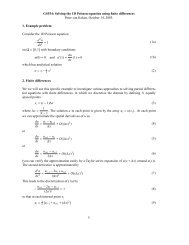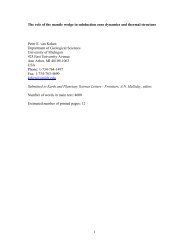Quantitative paleoenvironmental and paleoclimatic reconstruction ...
Quantitative paleoenvironmental and paleoclimatic reconstruction ...
Quantitative paleoenvironmental and paleoclimatic reconstruction ...
You also want an ePaper? Increase the reach of your titles
YUMPU automatically turns print PDFs into web optimized ePapers that Google loves.
ARTICLE IN PRESS<br />
N.D. Sheldon, N.J. Tabor / Earth-Science Reviews xxx (2009) xxx–xxx<br />
11<br />
sub-metamorphic burial conditions. This is particularly important for<br />
Paleozoic <strong>and</strong> older paleosols because smectite is meta-stable <strong>and</strong><br />
may be altered to illite in the presence of K-rich pore waters. Nonetheless,<br />
unless there is evidence of K metasomatism or illitization (<strong>and</strong><br />
this is primarily of interest in metamorphosed areas or with very old, i.e.,<br />
Precambrian, paleosols) from petrography or some other method, the<br />
CIA is a good tool for evaluating chemical weathering <strong>and</strong> for comparing<br />
different paleosols. Both the CIA-K of Maynard (1992) <strong>and</strong> PIA of Fedo<br />
et al. (1995) of B horizons in soils are well-correlated with mean annual<br />
precipitation (see Section 5.5; Sheldon et al., 2002), so the primary<br />
recent use of the CIA-K has been for estimating <strong>paleoclimatic</strong> conditions<br />
(e.g., Nordt et al., 2006; Hamer et al., 2007a,b).<br />
One final consideration with this type of weathering index is that<br />
there is one piece of nomenclatural confusion that has been propagated<br />
through the literature. The “chemical index of weathering”<br />
(CIW; Harnois, 1988) <strong>and</strong> CIA-K (Maynard, 1992) were developed for<br />
different purposes (Harnois (1988) was concerned about the inconsistent<br />
behaviour of K during pedogenesis, <strong>and</strong> Maynard (1992) was<br />
concerned about K addition by metasomatism), but, nevertheless,<br />
involve the same equation:<br />
Al<br />
CIWðCIA − KÞ = 100 ×<br />
Al þ Ca þ Na<br />
Retallack (various, e.g., 2001b; see Colman, 1982) has advocated a<br />
slightly different weathering index because while CIA <strong>and</strong> its variants<br />
give a good accounting of feldspar weathering, other types of minerals<br />
are not necessarily captured by that index, in particular Mg-bearing<br />
minerals. The ΣBases/Al ratio (Table 3) is designed to overcome this<br />
<strong>and</strong> is calculated with the following expression (again, using<br />
molecular values for each element):<br />
P Bases<br />
Al<br />
Ca þ K þ Mg þ Na<br />
=<br />
Al<br />
The ΣBases/Al ratio is susceptible to the same potential issues with<br />
metasomatically altered paleosols as the CIA, but again, unless there is<br />
some reason to suspect post-burial alteration, the ratio may be used to<br />
describe weathering of paleosols. ΣBases/Al has been used for a<br />
variety of purposes including characterizing weathering intensity<br />
(e.g., Retallack, 1999; Bestl<strong>and</strong>, 2000; Retallack <strong>and</strong> Krull, 1999;<br />
Sayyed <strong>and</strong> Hundekari, 2006) <strong>and</strong> for taxonomic purposes (Sheldon<br />
et al., 2002). Sayyed <strong>and</strong> Hundekari (2006) compared a variety of<br />
weathering ratios including the ΣBases/Al ratio to examine differences<br />
between near-modern <strong>and</strong> Cretaceous weathering on “red bole”<br />
<strong>and</strong> “green bole” paleosols formed on Deccan Traps basalt flows. A<br />
ΣBases/Al ratio of 0.5 is a statistically significant dividing line between<br />
Alfisols (N0.5; dystric Argillisols) <strong>and</strong> Ultisols (b0.5; eutric Argillisols);<br />
that criterion is roughly equivalent to the Soil Survey Staff<br />
(2006) base saturation criteria of 35% to separate between base-rich<br />
Alfisols <strong>and</strong> base-poor Ultisols (Sheldon et al., 2002). An example<br />
where that criterion was applied can be found in Sheldon (2005), who<br />
used it to confirm a field identification of Alfisol-like paleosols. In<br />
addition, Clechenko et al. (2007) discuss a thick paleosol associated<br />
with the Paleocene–Eocene boundary as being comparable to a<br />
modern Ultisol. Using data from their paper (their Table 1), an average<br />
ΣBases/Al of 0.3 is obtained for the paleosols, lending additional<br />
support to this criterion as a means for distinguishing between paleo-<br />
Alfisols <strong>and</strong> paleo-Ultisols. A further application of the ΣBases/Al ratio<br />
can be found in Perez-Huerta <strong>and</strong> Sheldon (2006), who used it to<br />
examine how short-term sea level (i.e., glacio-eustatic) changes<br />
affected nutrient availability in shallow marine settings where the<br />
ΣBases/Al ratio was used to represent the fluctuating continental<br />
input derived from soils.<br />
ð6Þ<br />
ð7Þ<br />
Darmody et al. (2005) presented two other measurements of<br />
chemical weathering that they applied to modern soil formation with<br />
granitic parent materials:<br />
WI − 1=<br />
WI − 2=<br />
Si þ Ca<br />
Fe þ Ti<br />
Si þ Ca<br />
Fe þ Ti þ Al<br />
Darmody et al. (2005) found strong positive correlations between<br />
WI-1, WI-2, <strong>and</strong> Si/Al [1/“clayeyness” (Section 5.2.1)], <strong>and</strong> strong<br />
negative correlations with the CIW of Harnois (1988), suggesting that<br />
all of the ratios were capturing weathering intensity. To date, Eqs. (8)<br />
<strong>and</strong> (9) have not been widely applied to paleosols. One exception is<br />
Kahmann et al. (2008), who compared results between a number of<br />
indices <strong>and</strong> found that WI-1 <strong>and</strong> WI-2 were in relatively poor<br />
concordance with other weathering indices <strong>and</strong> also with estimates of<br />
mean annual precipitation derived from CIA-K values (see Section<br />
5.5.3). However, the parent material being studied by Kahmann et al.<br />
(2008; sediments) was very different than that being studied by<br />
Darmody et al. (2005). Thus, at this point, results using Eqs. (8)<br />
<strong>and</strong> (9) are equivocal <strong>and</strong> more testing is needed to determine if the<br />
relationships that Darmody et al. (2005) found are widely applicable<br />
or only apply to cases with granitic parent materials.<br />
5.2.3. Trace element ratios<br />
Trace element abundances vary considerably among different<br />
paleosol types <strong>and</strong> parent materials. In general, to be useful a trace<br />
element must be present at the 10 s–100 s ppm level, because the<br />
analytical uncertainty using either XRF or ICP is a couple of ppm. As<br />
with major elements, ratios between trace elements are favoured both<br />
as means of normalizing differences but also because different<br />
elements are gained or lost due to different pedogenic processes.<br />
Trace element geochemistry in paleosols has been used for a variety of<br />
applications including examining weathering intensity (e.g., Kahmann<br />
et al., 2008), evaluating leaching (Sheldon, 2006a; Retallack,<br />
2001a,b, 1999), <strong>and</strong> for provenance (Hamer et al., 2007b; Sheldon<br />
et al., 2009; Sheldon, 2006a). The most commonly used ratio is Ba/Sr,<br />
which is thought to represent leaching behaviour during weathering<br />
(Table 3; Sheldon, 2006a; Retallack, 2001b), where higher values<br />
represented more leaching. Both are alkaline earth elements <strong>and</strong> have<br />
similar atomic radii <strong>and</strong> similar chemical affinities, but Sr is<br />
significantly more soluble than Ba (Vinogradov, 1959), so under<br />
most conditions it will be leached more readily. Thus, a heavily<br />
leached paleosol should have relatively lower Ba/Sr ratios near the top<br />
of the profile <strong>and</strong> relatively high Ba/Sr ratios lower in the profile if a B<br />
horizon is present (Sheldon, 2006a). The Ba/Sr ratio has been used to<br />
characterize leaching behaviour in paleosols throughout the geologic<br />
record including Precambrian (Retallack <strong>and</strong> Mindszenty, 1994),<br />
Permian–Triassic (Krull <strong>and</strong> Retallack, 2000; Sheldon, 2006a), <strong>and</strong><br />
Cenozoic (Terry, 2001) examples. There are two potential weaknesses<br />
of applying the Ba/Sr ratio. First, the chemical behaviour of Ba is less<br />
well understood than Sr, particularly in soils. Second, different parent<br />
materials have variable initial concentrations (<strong>and</strong> textures due to<br />
different mineral composition), so relatively minor changes in absolute<br />
abundance in samples with small initial amounts could be<br />
interpreted as intensive leaching when the process was of relatively<br />
little importance.<br />
An additional trace element ratio that is potentially useful is U/Th<br />
(Table 3). U <strong>and</strong> Th are both actinide elements; This typically more<br />
abundant in most potential parent rocks except for limestones (e.g., Li,<br />
2000). Th <strong>and</strong> U are both relatively immobile during weathering<br />
except under intense conditions (Li, 2000), or where there is a strong<br />
ð8Þ<br />
ð9Þ<br />
Please cite this article as: Sheldon, N.D., Tabor, N.J., <strong>Quantitative</strong> <strong>paleoenvironmental</strong> <strong>and</strong> <strong>paleoclimatic</strong> <strong>reconstruction</strong> using paleosols, Earth-<br />
Science Reviews (2009), doi:10.1016/j.earscirev.2009.03.004















